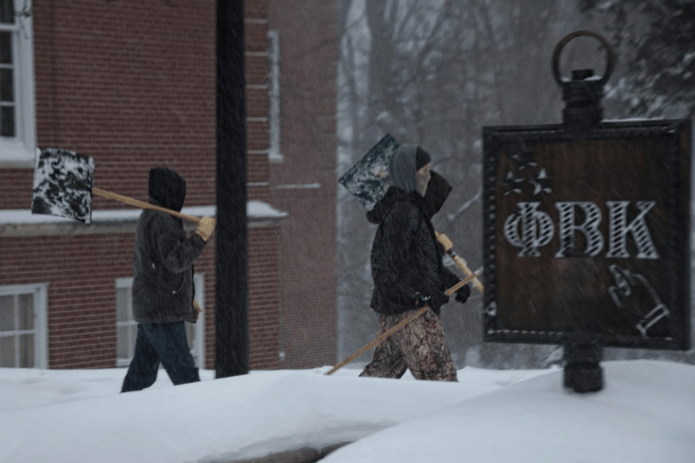The unsung heroes of the UMW snow crisis
4 min read
Girard Bucello | Blue & Gray Press
By ETHAN TOBIN
Students across the University of Mary Washington’s campus witnessed the first snowflakes of the long- anticipated Winter Storm Jonas, which began on Friday, Jan. 22 at 2 p.m. and lasted through early Sunday morning, dumping an estimated 18 inches of snow accumulation and ice, leaving campus closed Friday through Tuesday.
While Netflix, sledding and hot chocolate filled the agendas of many students, who was left to bear the burden of clearing snow and ice? To many, it is generally unknown who the men and women are behind the shovel.
“I’m not entirely sure whose task it is to remove snow on campus, but I’d assume these are workers employed within the University,” Miguel Marx, junior geology and biology double major, said. Marx, like many other students, are left questioning who and what departments are responsible for campus safety during weather emergencies like Jonas.
The responsibility of the task begins with John Wiltenmuth, the associate vice president of Facilities Services. According to Wiltenmuth, a host of employees from different departments, approximately 60 people, are responsible for maintaining safe traveling during the storm.
“The crew of workers students see around campus working diligently to create safe travel conditions for students consist of roughly sixty workers comprised of our very own grounds crew, campus trade shops such as campus electricians and outside contracting companies who are hired additionally to provide more hands,” Wiltenmuth said.
Wiltenmuth provided further details about the conditions of work his snow removal teams go through, and emphasized the intense measures his workers took to ensure that campus was efficiently and effectively cleared.
“Since Friday night, snow removal teams worked around the clock in two 12-hour shifts,” Wiltenmuth said. “The day shift being from 7 a.m. to 7 p.m. and the night shift lasting from 7 p.m. to 7 a.m. This cycle lasted for five days.”
When workers were not on their 12-hour shifts, they were provided with food as well as rooms at a nearby hotel where they could catch up on sleep and relax between their rigorous shifts. Wiltenmuth stressed that in addition to their hard work, “Our workers spent the entire weekend away from their families which has been tough on them.”
Alongside Wiltenmuth, whose responsibility is to oversee all operations and employees, Joni Wilson, director of Landscape, Grounds and Sustainability, is tasked with coordinating where workers will be removing snow and what equipment will be used. “How we determine where and when to utilize tractors, snow blowers and other removal equipment, and how we deploy workers from point A to point B on campus all fall through me,” Wilson said.
The heavy snowfall and the unpredictable nature of the storm has also been a challenge to the department, according to Wilson.
“The amount of snowfall we got was immense and the amount that kept falling for over 24 hours straight created difficult circumstances for crews. Figuring out how to remove the snow and where to put it has been a frustrating task,” Wilson said.
Director of Maintenance Services Dan Quann commented similar to Wilson that determining where to put the snow has been a difficult task. Quann noted that “Navigating through our campus parking spaces has been most difficult. With the amount of snow fallen, we are limited in our options of where to move the snow to clear space,” Quann said. “Having to complete this task while maneuvering around cars is tricky.”
Quann pointed out that in some cases, the only option when dealing with cars to maximize clearing ability to create a safe environment for students was to have cars towed. However, Quann reassured that while cars were towed in the snow removal process, “Student cars that were towed were sent to the University Tennis Center parking lot to avoid having students get charged.”
Wiltenmuth emphasized that the top priority for his department in the case of this storm has been student safety.
“Our top priorities are establishing safe pathways to and from residential buildings and the University Center where food is provided to students. Student safety is on our minds around the clock,” Wiltenmuth said.
Though the storm has been difficult on both students and employees involved, gratitude toward employees’ long hours and quick decision-making has not been forgotten, according to Marx.
“I think I can speak on behalf of all student residents around campus by saying that whoever’s task it is to clear snow and ensure our safety, they are doing an exceptional job and we greatly appreciate their efforts,” said Marx. “Without their incredible work, our daily routines would not be possible.”
By Monday following this major storm, students like Marx were able to resume regular activities, having full access to all corners of campus. This was made possible by the men and women who worked around the clock to ensure a clear and safe campus for everyone.












I also measured 2 cm in Kitchener (Stanley Park area) from a snsowquall which hit between midnight and 1 AM. It was hard to believe that on Hallowe’en it was back to the 18 C range and shirt sleeves.